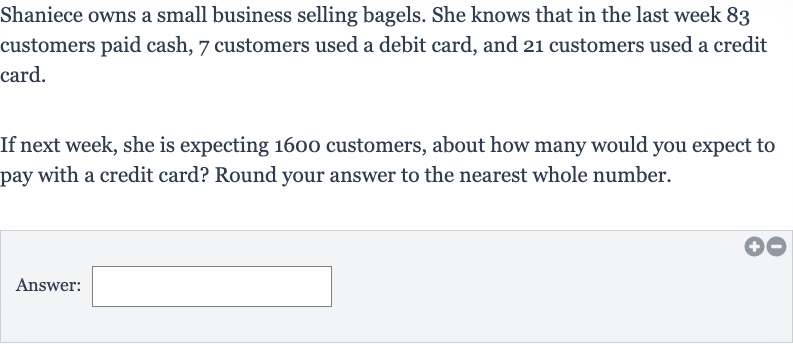AI tutor
Welcome to Bytelearn!
Let’s check out your problem:

Shaniece owns a small business selling bagels. She knows that in the last week customers paid cash, customers used a debit card, and customers used a credit card.If next week, she is expecting customers, about how many would you expect to pay with a credit card? Round your answer to the nearest whole number.Answer:
Full solution
Q. Shaniece owns a small business selling bagels. She knows that in the last week customers paid cash, customers used a debit card, and customers used a credit card.If next week, she is expecting customers, about how many would you expect to pay with a credit card? Round your answer to the nearest whole number.Answer:
- Calculate total customers: Calculate the total number of customers from last week.Customers who paid cash: Customers who used a debit card: Customers who used a credit card: Total number of customers last week = Total number of customers last week =
- Calculate credit card proportion: Calculate the proportion of customers who paid with a credit card last week.Proportion of credit card payments Number of customers who used a credit card Total number of customersProportion of credit card payments
- Calculate expected credit card customers: Calculate the expected number of customers who will pay with a credit card next week.Expected number of credit card payments Expected number of credit card payments
- Perform calculation for expected customers: Perform the calculation to find the expected number of credit card payments.Expected number of credit card payments = Expected number of credit card payments Expected number of credit card payments
- Round expected credit card payments: Round the expected number of credit card payments to the nearest whole number.Rounded expected number of credit card payments
More problems from Make predictions
QuestionGet tutor help
QuestionGet tutor help
QuestionGet tutor help
QuestionGet tutor help
QuestionGet tutor help
QuestionGet tutor help
QuestionGet tutor help
QuestionGet tutor help
QuestionGet tutor help
